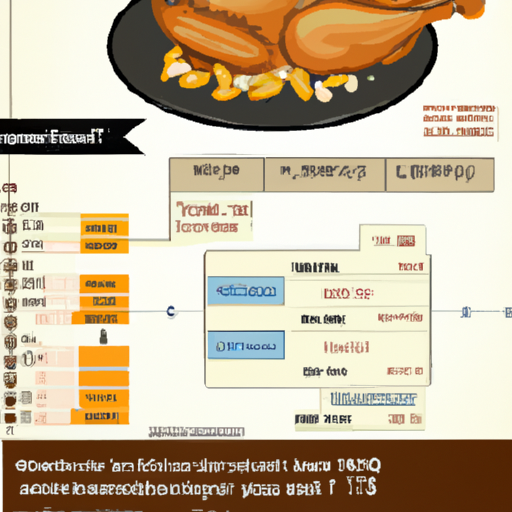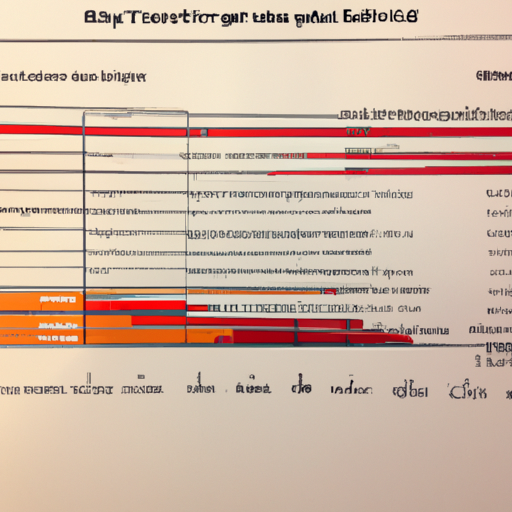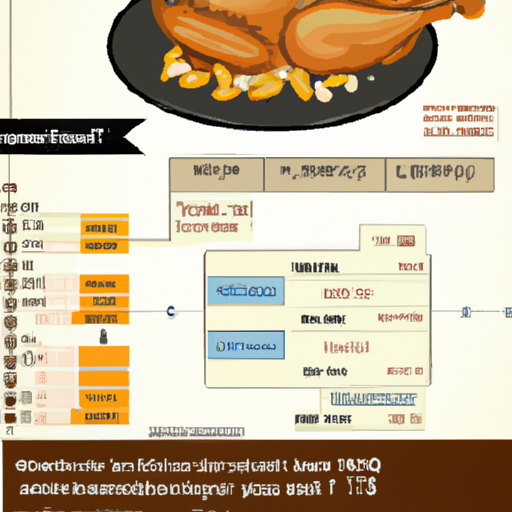You’ve probably experienced the frustration of overcooking or undercooking your meals, resulting in a less than ideal dining experience. But worry no more, because the solution is here! Introducing the “Easy Cooking with Internal Temperature Chart,” a handy tool that takes the guesswork out of cooking. With this convenient chart, you’ll know exactly what temperature your food needs to reach for perfect doneness, whether you’re grilling steaks, roasting chicken, or baking a cake. No more dry or raw dishes – just delicious, perfectly cooked meals every time.

Importance of Internal Temperature in Cooking
Why is Internal Temperature Important?
When it comes to cooking, understanding and monitoring the internal temperature of your food is crucial. The internal temperature directly affects the doneness, food safety, and overall taste and texture of your dishes. Cooking at the correct internal temperature ensures that your food is safe to eat, retains its moisture, and is cooked to perfection.
Benefits of Cooking at the Correct Internal Temperature
Cooking at the correct internal temperature offers numerous benefits that go beyond simply ensuring food safety. By cooking your food to the right temperature, you can achieve optimal tenderness, juiciness, and flavor. Additionally, cooking at the correct temperature helps prevent the risk of foodborne illnesses while maximizing the nutritional value of your meals. Understanding and using internal temperature charts can greatly enhance your cooking skills and elevate your dishes to a whole new level.
Understanding Internal Temperature
What is Internal Temperature?
Internal temperature refers to the temperature inside the thickest part of the food, which is typically measured using a meat thermometer. This temperature is a reliable indicator of the doneness of your food. Different types of foods have different internal temperature ranges that are considered safe for consumption.
Internal Temperature and Doneness
The internal temperature of food determines its doneness and plays a vital role in achieving the desired cooking level. For example, a steak cooked to medium-rare will have a different internal temperature compared to a well-done steak. By understanding the ideal internal temperature for specific types of food, you can ensure that your dishes are cooked to your preference.
Factors Affecting Internal Temperature
Several factors can affect the internal temperature of food during cooking. These include the thickness and size of the food, the cooking method used, the starting temperature, and even the altitude. It is important to consider these factors and make adjustments accordingly while cooking to ensure that your food reaches the correct internal temperature.
Using an Internal Temperature Chart
What is an Internal Temperature Chart?
An internal temperature chart is a valuable reference tool that provides guidelines for the ideal internal temperature of various types of food. It helps take the guesswork out of cooking and ensures that your food is cooked to perfection, both in terms of safety and taste.
Types of Internal Temperature Charts
There are different types of internal temperature charts available, depending on the type of meat or food being cooked. Common charts include those for beef, poultry, fish, pork, lamb, and even vegetables. Each chart provides specific temperature recommendations based on the desired level of doneness.
Choosing the Right Internal Temperature Chart
When choosing an internal temperature chart, it is important to consider the type of food you will be cooking. Different meats require different internal temperatures to reach the desired level of doneness. Make sure to refer to a reliable and accurate chart that suits your needs.
Common Internal Temperature Recommendations
Internal Temperature Chart for Beef
When cooking beef, the ideal internal temperature depends on the desired doneness. For a rare steak, aim for an internal temperature of 125°F (52°C) to 130°F (54°C). Medium-rare is usually achieved at 135°F (57°C) to 140°F (60°C), while medium is around 145°F (63°C) to 160°F (71°C). Well-done beef should have an internal temperature of 160°F (71°C) or above.
Internal Temperature Chart for Poultry
Cooking poultry, such as chicken or turkey, to the correct internal temperature is crucial for food safety. The internal temperature for cooked poultry should be at least 165°F (74°C) to ensure that it is safe to consume. It is important to measure the temperature at the thickest part of the meat, avoiding bones.
Internal Temperature Chart for Fish
Fish is a delicate protein that requires careful cooking to maintain its moisture and flavor. The internal temperature for cooked fish varies depending on the type and thickness. Generally, fish is considered done when the internal temperature reaches 145°F (63°C). It should be opaque and easily flakes with a fork.
Internal Temperature Chart for Pork
Pork, like beef, can be cooked to different levels of doneness. For juicy and tender pork, aim for an internal temperature of 145°F (63°C) to 160°F (71°C) for medium. If you prefer well-done pork, the internal temperature should reach 160°F (71°C) or higher. Ground pork, however, should reach a minimum internal temperature of 160°F (71°C).
Internal Temperature Chart for Lamb
Lamb can be cooked to different internal temperatures depending on personal preference. For a juicy and pink medium-rare lamb, aim for an internal temperature of 130°F (54°C) to 135°F (57°C). Medium lamb is around 140°F (60°C) to 150°F (66°C), while well-done lamb should reach 160°F (71°C) or higher.
Internal Temperature Chart for Vegetables
While vegetables do not require specific internal temperatures for safety, it is still useful to know the ideal cooking temperatures to achieve optimal texture and flavor. Generally, most vegetables are cooked to perfection when they reach an internal temperature of 160°F (71°C) to 185°F (85°C), depending on the desired level of tenderness.

Tips for Safe and Easy Cooking
Using a Meat Thermometer
A meat thermometer is an essential tool for accurately measuring the internal temperature of your food. Choose a reliable and calibrated thermometer and ensure that it is inserted into the thickest part of the meat without touching any bones. This will give you an accurate reading of the internal temperature.
Proper Meat Thermometer Placement
When using a meat thermometer, it is crucial to place it correctly to get an accurate measurement. For thicker cuts of meat, such as roasts or whole poultry, insert the thermometer into the thickest part of the meat, avoiding bones. For thinner cuts, such as steaks or chicken breasts, insert the thermometer sideways into the center of the meat.
Preventing Overcooking or Undercooking
By following internal temperature guidelines and using a meat thermometer, you can prevent the common mistakes of overcooking or undercooking your food. This ensures that your dishes are not only safe to eat but also retain their desired texture and flavors.
Resting Meat after Cooking
After removing meat from the heat source, allow it to rest for a few minutes before carving or serving. This resting period allows the internal temperature to equalize and the juices to redistribute, resulting in a more tender and flavorful final dish.
Storing and Handling Leftovers
Properly storing and handling leftovers is essential to maintain food safety. Once cooked, refrigerate or freeze any leftovers promptly to prevent bacterial growth. When reheating, ensure that the internal temperature reaches a safe level to eliminate any potential bacteria.
Cooking Methods and Internal Temperatures
Internal Temperature for Grilling
Grilling is a popular cooking method that requires attention to internal temperature to ensure food safety and excellent flavor. When grilling, refer to internal temperature charts for specific cuts of meat and adjust cooking times accordingly. Use a meat thermometer to check for doneness, aiming for the recommended internal temperature.
Internal Temperature for Roasting
Roasting is a versatile cooking method that allows for the creation of succulent and flavorful dishes. For roasted meats, internal temperature is of utmost importance. Refer to internal temperature charts and cook your roast to the desired doneness by monitoring the internal temperature throughout the cooking process.
Internal Temperature for Baking
Baking is a precise cooking method, and internal temperature is crucial for achieving perfectly cooked baked goods. Use internal temperature charts as a guide for the ideal internal temperature of cakes, bread, and other baked treats. Ensure that the center of the baked goods reaches the recommended internal temperature to ensure they are fully cooked.
Internal Temperature for Sauteing
Sauteing is a quick and convenient cooking method that requires attention to internal temperature to ensure food safety and proper doneness. When sauteing meats or vegetables, use a meat thermometer to check the internal temperature for thorough cooking. Adjust the cooking time if necessary to reach the recommended temperature.
Internal Temperature for Sous Vide Cooking
Sous vide cooking relies heavily on precise temperature control to achieve perfectly cooked dishes. With sous vide, the food is vacuum-sealed and cooked in a water bath at a controlled temperature. Internal temperature charts play a crucial role in determining the cooking time and temperature required for different types of meat and ingredients.
Internal Temperature for Slow Cooking
Slow cooking is a popular method for tenderizing tough cuts of meat and infusing flavors. When using a slow cooker or crockpot, it is important to consider the internal temperature to ensure the meat reaches the desired level of tenderness and safety. Refer to internal temperature charts specific to slow cooking to achieve optimal results.
Common Questions about Internal Temperature
How Accurate are Meat Thermometers?
Meat thermometers are generally accurate when used correctly. However, it is essential to ensure that your meat thermometer is calibrated properly and functions accurately before each use. Regularly test the accuracy of your thermometer using ice water or boiling water to ensure reliable temperature readings.
Can I Always Rely on the Internal Temperature Chart?
Internal temperature charts are reliable guidelines for cooking, but personal preferences, equipment variations, and other factors may affect the results. Always refer to an updated internal temperature chart from a reliable source and adjust your cooking based on personal experience and preferences.
What to Do If I Don’t Have a Meat Thermometer?
While a meat thermometer is the most accurate way to measure internal temperature, there are alternative methods to determine doneness. For example, you can visually check for certain signs of doneness, such as color, texture, and juice color. However, these methods are less precise and may pose a higher risk of overcooking or undercooking.
Is It Safe to Eat Undercooked Meat if I Freeze It?
Freezing does not kill the bacteria present in undercooked meat. It is not safe to eat undercooked meat, even if you plan to freeze it for later consumption. To ensure food safety, it is crucial to cook meat to the proper internal temperature before freezing or consuming.
Can I Use the Same Internal Temperature for Different Cuts of Meat?
Different cuts of meat have varying characteristics, thicknesses, and recommended cooking methods. Therefore, it is not advisable to use the same internal temperature for all cuts of meat. Always refer to specific internal temperature recommendations for each type of meat and adjust accordingly.
Internal Temperature vs Cooking Time
Understanding the Relationship between Internal Temperature and Cooking Time
The relationship between internal temperature and cooking time can vary depending on numerous factors such as the type of food, cooking method, size, and thickness. While cooking times can provide a rough estimate, internal temperature is a more accurate indicator of doneness.
Using Internal Temperature to Determine Cooking Time
Instead of solely relying on cooking time guidelines, it is recommended to use internal temperature as the primary indicator of when a dish is perfectly cooked. Refer to an internal temperature chart specific to the food you are cooking, and monitor the temperature throughout the cooking process to determine the ideal cooking time.
Adjusting Cooking Time Based on Internal Temperature
When using internal temperature as a guide, it may be necessary to adjust the cooking time accordingly. Factors such as the starting temperature of the food, cooking method, and personal preferences can influence the required cooking time. Use internal temperature as a reference point and adapt the cooking time to achieve the desired results.
Recipes and Internal Temperature Guidelines
Steak with Medium Rare Internal Temperature
To cook a steak to medium-rare perfection, follow these guidelines: Preheat a grill or skillet on medium-high heat. Season the steak with salt, pepper, and any desired spices. Place the steak on the hot grill or skillet and cook for about 4-5 minutes on each side, or until the internal temperature reaches 135°F (57°C) to 140°F (60°C). Let the steak rest for a few minutes before serving to allow the juices to redistribute.
Roast Chicken with Safe Internal Temperature
To prepare a roast chicken with a safe internal temperature, preheat the oven to 425°F (220°C). Season the chicken with salt, pepper, and herbs. Place the chicken on a roasting rack in a baking dish and roast for approximately 20 minutes per pound, or until the internal temperature reaches a minimum of 165°F (74°C) at the thickest part of the thigh. Let the chicken rest for a few minutes before carving.
Grilled Salmon with Perfect Internal Temperature
Grilling salmon to the perfect internal temperature ensures a moist and flavorful result. Preheat the grill to medium-high heat. Season the salmon fillets with salt, pepper, and any desired herbs or spices. Place the fillets on the grill, skin side down, and cook for about 4-6 minutes per side, or until the internal temperature reaches 145°F (63°C). Remove from the grill and let it rest for a few minutes before serving.
Pork Chops with Juicy Internal Temperature
To achieve juicy pork chops, preheat a skillet or grill on medium-high heat. Season the chops with salt, pepper, and spices. Cook the chops for about 4-5 minutes per side, or until the internal temperature reaches 145°F (63°C) to 160°F (71°C) for medium. Let the pork chops rest for a few minutes before serving to allow the juices to redistribute.
Lamb Chops with Tender Internal Temperature
For tender lamb chops, preheat a skillet or grill on medium-high heat. Season the chops with salt, pepper, and herbs. Cook the chops for about 3-4 minutes per side, or until the internal temperature reaches 130°F (54°C) to 135°F (57°C) for medium-rare. Adjust the cooking time for different levels of doneness. Let the lamb chops rest for a few minutes before serving.
Perfectly Cooked Vegetables with Ideal Internal Temperature
To cook vegetables to perfection, start by bringing a pot of salted water to a boil. Add the vegetables and cook until they reach an internal temperature of 160°F (71°C) to 185°F (85°C) or until they are tender when pierced with a fork. Remove the vegetables from the water and immediately transfer them to an ice bath to stop the cooking process. This technique, known as blanching, helps retain the vibrant color and crispness of the vegetables.
Conclusion
Mastering the art of cooking with internal temperature is a game-changer that can take your culinary skills to new heights. By understanding the importance of internal temperature, you can ensure food safety, achieve perfect doneness, and enhance the overall flavors and textures of your dishes. Utilize internal temperature charts, follow recommended guidelines, and experiment with different cooking temperatures to unleash your culinary potential. So, grab your meat thermometer and embark on a journey of safe, flavorful, and perfectly cooked meals!
